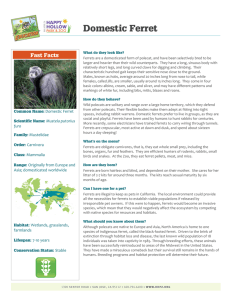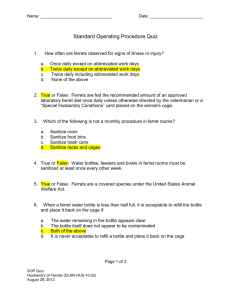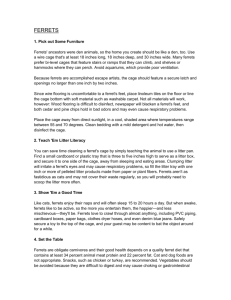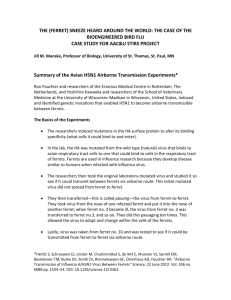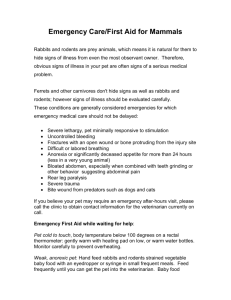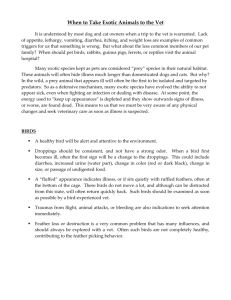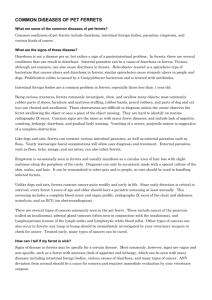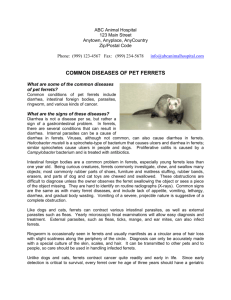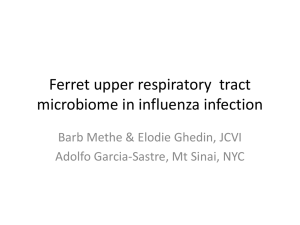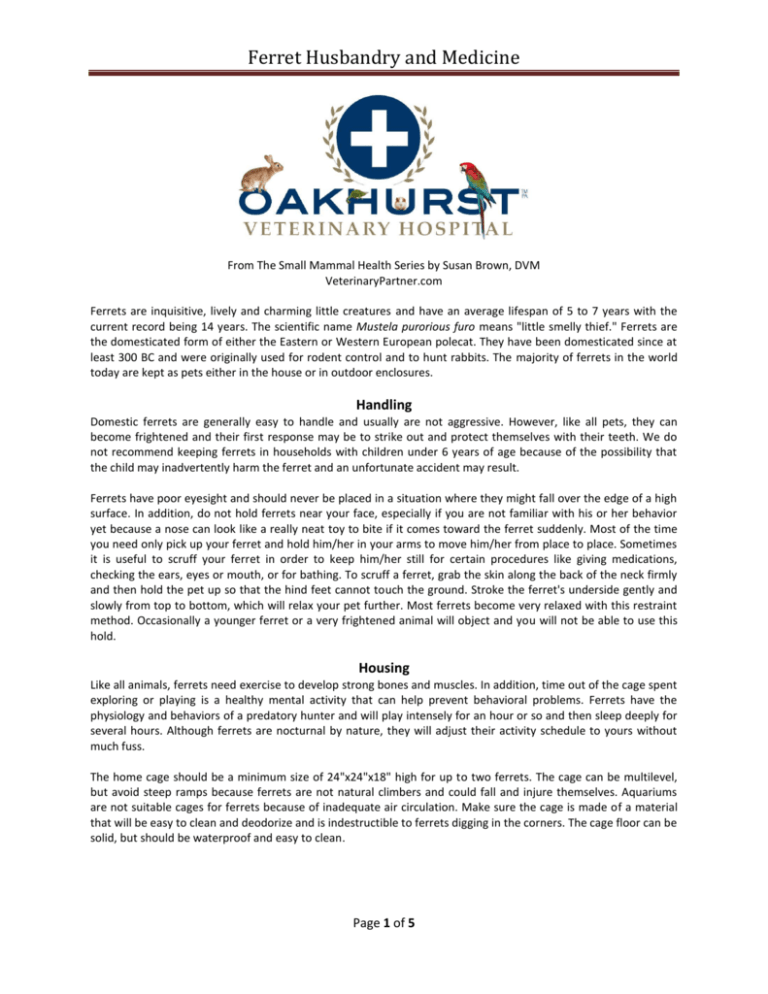
Ferret Husbandry and Medicine
From The Small Mammal Health Series by Susan Brown, DVM
VeterinaryPartner.com
Ferrets are inquisitive, lively and charming little creatures and have an average lifespan of 5 to 7 years with the
current record being 14 years. The scientific name Mustela purorious furo means "little smelly thief." Ferrets are
the domesticated form of either the Eastern or Western European polecat. They have been domesticated since at
least 300 BC and were originally used for rodent control and to hunt rabbits. The majority of ferrets in the world
today are kept as pets either in the house or in outdoor enclosures.
Handling
Domestic ferrets are generally easy to handle and usually are not aggressive. However, like all pets, they can
become frightened and their first response may be to strike out and protect themselves with their teeth. We do
not recommend keeping ferrets in households with children under 6 years of age because of the possibility that
the child may inadvertently harm the ferret and an unfortunate accident may result.
Ferrets have poor eyesight and should never be placed in a situation where they might fall over the edge of a high
surface. In addition, do not hold ferrets near your face, especially if you are not familiar with his or her behavior
yet because a nose can look like a really neat toy to bite if it comes toward the ferret suddenly. Most of the time
you need only pick up your ferret and hold him/her in your arms to move him/her from place to place. Sometimes
it is useful to scruff your ferret in order to keep him/her still for certain procedures like giving medications,
checking the ears, eyes or mouth, or for bathing. To scruff a ferret, grab the skin along the back of the neck firmly
and then hold the pet up so that the hind feet cannot touch the ground. Stroke the ferret's underside gently and
slowly from top to bottom, which will relax your pet further. Most ferrets become very relaxed with this restraint
method. Occasionally a younger ferret or a very frightened animal will object and you will not be able to use this
hold.
Housing
Like all animals, ferrets need exercise to develop strong bones and muscles. In addition, time out of the cage spent
exploring or playing is a healthy mental activity that can help prevent behavioral problems. Ferrets have the
physiology and behaviors of a predatory hunter and will play intensely for an hour or so and then sleep deeply for
several hours. Although ferrets are nocturnal by nature, they will adjust their activity schedule to yours without
much fuss.
The home cage should be a minimum size of 24"x24"x18" high for up to two ferrets. The cage can be multilevel,
but avoid steep ramps because ferrets are not natural climbers and could fall and injure themselves. Aquariums
are not suitable cages for ferrets because of inadequate air circulation. Make sure the cage is made of a material
that will be easy to clean and deodorize and is indestructible to ferrets digging in the corners. The cage floor can be
solid, but should be waterproof and easy to clean.
Page 1 of 5
Ferret Husbandry and Medicine
Ferrets should be allowed to exercise in a supervised, ferret-proofed exercise area a minimum of 2 hours a day.
This exercise period can be all at once or divided up into two or three play periods. Ferrets in the wild would spend
a good deal of time in burrows underground, eating, sleeping and hunting. Think like a ferret, get down on your
hands and knees and look for areas that might be attractive to him or her to dig or burrow into. Make sure you
block off all escape routes and remove toxic substances such as plants, household cleaners, insecticides and
rodenticides. Protect the carpeting from digging with heavy plastic carpet protectors. Keep your pet from
burrowing into the bottom of your furniture or mattresses by covering these areas with a solid piece of thin
plywood, hardware cloth, or Plexiglas®. The burrowing is not only damaging to the furniture, but the ferret can eat
the foam rubber inside and develop a fatal intestinal obstruction. Recliner chairs should be removed because
ferrets like to climb into the chairs to sleep and when the chair is reclined, the ferret can be crushed. Some pet
stores and internet ferret supply sites sell moveable ferret exercise pens that are great for allowing your pet to
have time outside of the cage while being protected from dangerous situations. You can place a mat under the pen
to keep the floor clean.
Sleeping Area - In the wild, ferrets would sleep in a dark, warm, dry nest underground. We need to simulate this
same environment by providing sleeping material in which a ferret can feel safe. A sleeping area can be as simple
as a soft towel, old shirt or cut off trouser leg or blouse sleeve. There are now a wide variety of sleeping
paraphernalia for ferrets sold at pet stores such as cloth tubes, tents and hammocks. Occasionally, a ferret will
chew on cloth, but this is usually baby behavior and most ferrets grow out of it. If your pet does chew on cloth,
remove the item from the cage and use a small cardboard or wooden box with clean straw or hay for a sleeping
area. After the ferret matures try the cloth sleeping materials again.
Litter Box - Ferrets can be litter box trained. Ferrets like to use the bathroom in corners or where there is a vertical
surface. With this in mind, use a small cat litter box with low sides that can be placed in a corner of the cage or
exercise area. Do not use clay or clumping kitty litter in the box because ferrets like to burrow and play in the clean
litter and the dust from the clay is damaging to the fur. A pelleted or shredded bedding is preferable because it not
only prevents the problems mentioned, but they are often more absorbent and are non-toxic if swallowed. As
mentioned, ferrets back up to a vertical surface to defecate and urinate, so only a thin layer of litter is needed or
all the waste material will go over the side of the box! Ferrets do not cover up their waste so it will be necessary to
change the litter material several times a week to minimize stool odor. If the ferret is allowed to exercise over a
large area of the house it will be necessary to place litter boxes in several locations. When ferrets need to go, they
will not travel far to take care of the situation!
Toys
Never give your pet ferret any latex or foam rubber toys!!! Ferrets like to chew on and then swallow these
products and the result can be a fatal intestinal obstruction. Make sure to remove any access to foam or latex
rubber items in your home such as stereo speakers, headphones, rubber soled shoes, pipe insulation, rubber bands
and rubber dog, cat or baby toys. Prevent access to the underside of furniture and mattresses because these are
also sources of foam rubber. In additional, do not use any toys (like bean bags) that contain items inside such as
dried beans, nuts, grains or Styrofoam® pellets.
More appropriate toys are those that simulate the ferrets need for burrows or their attraction to hunting.
Appropriate tunnel-type toys would include large cardboard mailing tubes, dryer hose, paper bags and PVC pipe.
Toys that simulate moving prey include ping pong balls, small metal cans, golf balls, and small cloth baby toys or
feather cat toys on springs that hang. Do not use any cloth toys if your ferret shows an interest in chewing them,
but this is usually baby behavior and cloth is not a problem for adults. Remove buttons and eyes from any cloth
baby toys.
Page 2 of 5
Ferret Husbandry and Medicine
Diet
Ferrets are obligate carnivores, meaning they are designed to eat prey items, which includes all parts of the killed
animal. Plants, including fruits and vegetables, are not a significant part of a natural ferret diet. Ferrets have a very
short gastrointestinal (GI) tract and the intestinal flora (the organisms living in the GI tract) are very simple. It takes
about 3 to 4 hours for food to go from one end to the other and thus the food eaten must be of very high quality
because there is little time to digest and absorb it. Ferrets tend to eat several smaller meals and carry any excess
to their dens to eat later.
Because of the short GI tract and the poor absorption of nutrients, ferrets require a diet that is highly concentrated
with FAT as the main source of calories (energy) and highly digestible MEAT-BASED PROTEIN. Ferrets should never
be fed carbohydrates (such as vegetable, fruit or grains) as the main source of energy in the diet.
A dry ferret diet should contain at least 30% to 40% crude protein and 15% to 20% fat. The protein should be of
animal origin and highly digestible. For ferrets, the first three ingredients ideally should be meat-based. Ferrets do
not need supplements of any kind if they are being fed a balanced diet.
Vaccinations
Canine Distemper
Canine distemper virus (CDV) is a contagious disease that can be transmitted to ferrets directly from infected
animals including dogs, foxes, raccoons and other ferrets, or through contact with infected material such as shoes
or clothing. You can bring CDV home if you are in contact with infected material in places such as the woods, a pet
store or a breeding facility. Under normal circumstances, risk of exposure is low, but unfortunately, if a ferret
contracts CDV it is nearly 100% fatal.
The current recommendation is to have your pet vaccinated for CDV annually, based on risk of exposure. High risk
situations for ferrets to become exposed to CDV include ferret shows, exposure to wildlife (especially raccoons and
feral dogs), outdoor enclosures, outdoor camping, exposure to pet store animals (e.g. visiting the pet store with
your ferret), and ferrets who are constantly introduced to new ferrets (e.g. breeding, open enrollment play
groups). Baby ferrets receive a series of vaccinations with the completion at 14-16 weeks of age. Adult ferrets that
have never had CDV vaccination will initially receive a series of two boosters, then one annually thereafter. There
are CDV vaccines on the market that are labeled for use in ferrets.
Unfortunately, there is the possibility of an anaphylactic reaction to a vaccine in some ferrets. This occurs within a
few minutes of the vaccine administration and is generally severe vomiting, diarrhea, weakness, and collapse.
Because of this possibility, we require all ferrets receiving vaccines to remain at the veterinary hospital for 30-40
minutes after the vaccine has been given to monitor for any reactions.
Rabies
Rabies is caused by a virus that can affect many species of animals, including man. The virus is shed in the saliva
and transmission is usually through a bite wound. It can also be spread through contact of infected saliva with a
mucous membrane or any open wound. Since rabies is a human health issue, there are strict local and state
regulations that govern the vaccination of most domestic pets for rabies. In some areas of the country, if a ferret
bites a human and it was not vaccinated for rabies, the ferret will be confiscated and destroyed so the brain can be
examined for the rabies virus. This is the law and your lack of knowledge about it will not protect you or your pet.
Please find out before there is a problem what the laws are regarding rabies vaccination and ferret bites in your
area. It does not matter if your ferret was never exposed to rabies, the law will prevail. There is one approved oneyear vaccination for rabies in ferrets but there is no approved 3-year vaccine. Your pet ferret must be vaccinated
for Rabies annually to be legally licensed in NJ.
Page 3 of 5
Ferret Husbandry and Medicine
Common Medical Problems
Adrenal Disease
This is a very common disease of ferrets over 2 years of age. It is either a neoplasm (cancer) or hyperplasia
(unusually high activity) of the adrenal glands, which are located near the top of each kidney. These glands are part
of the endocrine, or hormone-producing system, of the body. For unknown reasons, in ferrets the adrenal glands
become diseased and can enlarge and produce excessive amounts of androgens, or sex hormones. This
overproduction of hormones results in a variety of signs including a loss of hair, increase in body odor,
enlargement of the vulva in spayed females, return of the mating or aggressive urge in neutered males, dry or
brittle hair coat, and itchy skin. In addition, some males can develop an enlargement of the prostate gland, which
constricts urinary outflow. These ferrets have difficulty urinating and eventually may not be able to urinate at all.
There are now many different possibilities for managing adrenal disease. There are a number of medical and
surgical options, as well as options that combine surgery and medical treatment.
Insulinoma
This is a neoplasm (cancer) of beta cells in the pancreas. This disease is just as common as adrenal disease and
often occurs at the same time. The beta cells in the pancreas produce insulin, which acts to move glucose from the
bloodstream into the cells. Diabetes is the LACK of insulin preventing glucose from getting into the cells, resulting
in a high glucose level in the bloodstream. Insulinoma is the opposite, an EXCESSIVE production of insulin that
drives the glucose out of the bloodstream and into the cells too quickly, resulting in a low blood sugar level. This
leaves the brain and red blood cells with an insufficient supply of "fuel for energy," which results in weakness,
excessive salivation, seizures and eventually death. These signs are seen intermittently because the body is
constantly trying to replace the glucose and early in the disease it can successfully do so for periods of time. As the
disease progresses, however, the ferret has longer and more frequent periods of abnormal behavior. The
treatment for this disease can be medical or surgical to remove as much of the cancer as possible. It is critical to
remove as much carbohydrate from the diet as possible as well because carbohydrates will only aggravate the
condition.
Other Cancers
For unknown reasons, ferrets are prone to a number of other neoplasms in addition to insulinomas and adrenal
cancer. Lymphosarcoma is a cancer of the lymphatic system and is the one cancer that can affect ferrets of any
age. The treatment is dependent on the cancer and the condition of the pet.
Foreign Bodies in the Stomach or Intestine
Ferrets, particularly under one year of age, love to eat foam and latex rubber, which can become lodged in the
intestine or stomach. In addition, ferrets over one year of age can develop large masses of hair in the stomach,
which also can cause an obstruction. Both of these situations are dangerous and usually require surgery to remove
the foreign material. Signs of a foreign body obstruction include lethargy, dehydration, weight loss, diarrhea,
vomiting, lack of stools, and a painful abdomen. The best prevention for this problem is to adequately ferret-proof
the environment as described previously.
Epizootic Catarrhal Enteritis (ECE)
This is the name given to "green slime disease" that has affected ferrets, particularly in pet stores and shelters,
since 1993. This commonly involves a new ferret addition to the household. The new ferret is healthy in
appearance but the established ferrets in the home get ill with vomiting and diarrhea. It is also possible for you to
bring in the disease after exposure to infected ferrets at pet stores or ferret shows. ECE spreads rapidly and ferrets
exposed will exhibit signs of disease within 48 to 72 hours. The signs of illness initially can range from vomiting and
a soft, green, mucous-coated stool to bloody diarrhea. Once treated, most ferrets recover uneventfully from ECE;
however, some ferrets, particularly older ones or those with other disease, can be severely affected. Recovered
ferrets and some unaffected ferrets may be carriers.
Page 4 of 5
Ferret Husbandry and Medicine
Human Influenza
Ferrets are highly susceptible to the human influenza virus or the "flu." They do not get the common cold, which is
caused by another set of viruses. Ferrets can get the flu from humans and humans can contract the flu from
ferrets, through contact with respiratory secretions. Adult ferrets develop a watery discharge from the eyes and
nose, sneezing, coughing and a fluctuating fever. Occasionally, they also develop diarrhea. They feel miserable for
a few days but usually recover uneventfully. Baby ferrets can be more severely affected, so avoid handling baby
ferrets if you have the flu. Your veterinarian may prescribe medications to make your pet more comfortable, but
antibiotics are not appropriate for this disease as it is viral, not bacterial. Basic supportive care (meeting fluid and
nutritional needs) is most important.
Copyright 2008 - 2012 by Susan Brown, DVM. Used with permission. All rights reserved
Page 5 of 5

